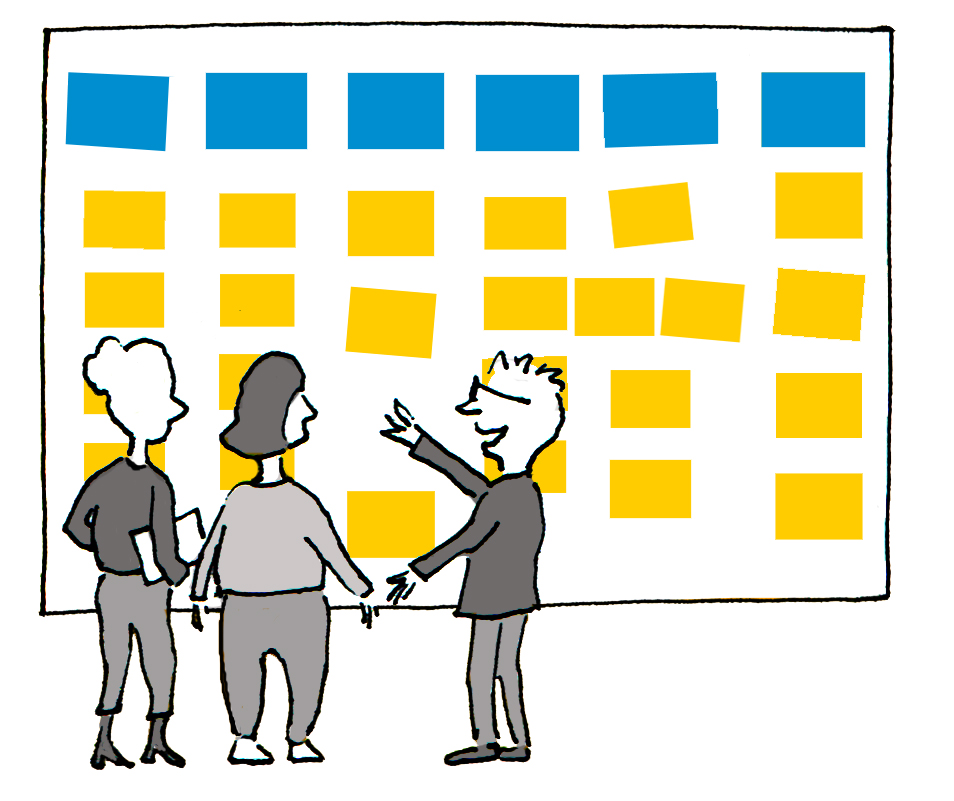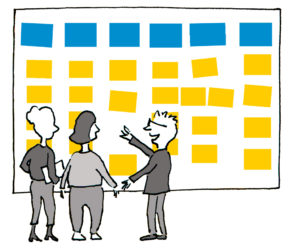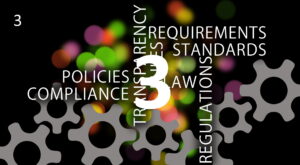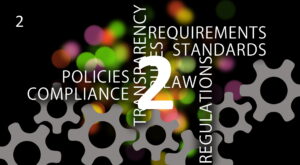
Denkplan © – Denkplan instrument overview
Quick Jump for fast readers

Denkplan: Three physical and interactive instruments
Denkplan plays on three levels
- The strategic impact level (used instrument: the impact map using a morphological box)
- The tactical roadmap level (used instrument: the roadmap using the concept of a story map)
- The roadmap flow level (used instrument: a Kanban board)
All instruments are physical instruments that foster the flow from strategy to action – whereas we understand “to action” as something done generating business value. The physical instruments are complemented by ceremonies and tools. As I already said, Denkplan is not e receipt to succeed. Denkplan requires to be adopted specific to the company. The impact map, the roadmap and the Kanban board must reflect the needs of the company. The ceremonies fit into the culture and the supporting tools like Jira exist manifold and as well company specific adopted.
The impact map for fast readers
The impact map supports knowledgeable persons in the company to identify fields of action where (strategy derived) change is required. In many companies important fields of action are unknown and overseen. Obvious measures are often dominant. These obvious measures cover and hide dependent or impacted fields that as well require action. The impact map strives to make unknown and overseen fields transparent. We call the fields of action ‘themes’. A theme summarizes a coherent set of potential actions to realize the aspired change.

The impact map – to develop red fields green we have to work on this an that as well…
Identifying smart themes is not the easiest game. The impact map is an offer to lead a valuable conversation with the knowledgeable persons in the company to identify the themes. In a later blog I discuss how to identify a context in this map that is aligned with the strategy and how to derive concrete action to make the strategy actionable.
The roadmap for fast readers
In the impact map we identified themes. Next step is to pull the themes into the second instrument – the roadmap. This instrument follows the ideas of Jeff Patton’s story mapping. The difference compared to Jeff’s approach is, that we use the this instrument on company level for all change, not on product or feature level.

The Roadmap – the backbone of strategy implementation
Themes are the backbone of change. Themes reflect what needs to be changed. In the roadmap, per theme, we pin in the steps how we would like to develop the themes over time. We call such a step an initiative. Small initiatives are good initiatives. Small in the sense of lead time. We place an initiative in the roadmap to the desired point in time when we hope to achieve the maximum business value out of it. Initiatives do have cross-theme dependencies. The roadmap helps us visualizing theme spanning dependencies. With this holistic visualization we are able to arrange the initiatives in a way to optimize the whole. Build initially, the roadmap typically visualizes our wish. I assure you, the first version is like the Christmas list of a teenager, who wants everything and this right now. This is not realistic. That’s exactly the game of the roadmap. Make it realistic. Appropriate feedback loops in the company are an essential mechanism to mature the roadmap to an as realistic as possible state – even leading to a feedback back to strategy adoption. Continuously feedback loops update the roadmap to always be as realistic as possible.
The portfolio Kanban for fast readers
Let’s assume the second level – working with the roadmap works fine – the next level is working with the portfolio Kanban board. The basic concept is as following. Latest after three or four feedback cycles the roadmap visualizes initiatives you are currently working on or are in the backlog as next candidates in the upper area. These are the ones for the portfolio Kanban. Visualized in a Kanban board you know the game played here. The game is
- Arrange the initiatives in the order to maximize business value. Shortest weighted job first might help you in this
- Use a pull system so that team can pull initiatives.
- The goal is to minimize the lead time of every single initiative
That sounds easy. Point is: the Kanban shows defects in your organization. Starting with the Kanban and observing the flow (or not-that-good-flow) you will learn a lot about your organization. For example that initiatives of a different type typically got stuck. Reason is probably one team that serializes all initiatives because it has some dependency in every single initiative. Probably the setup of the organization and the teams is wrong. The Kanban cannot solve this problem, but it makes such problems visible. You as company, you as member of the system are the only one who can find and implement a solution.
Well – that’s the overview and fast reader introduction to Denkplan. The next blog go into detail.
Denkplan © and the concepts behind is a registered trademark of DoD!fferent GmbH, Saraes Media GmbH and Juropera GmbH.
 Previous Post
Previous Post

